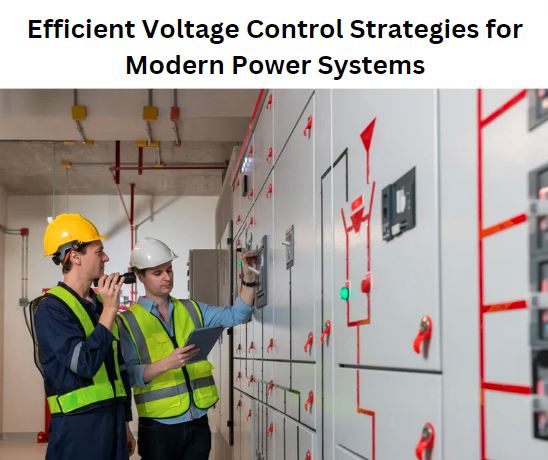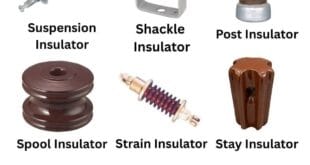Efficient Voltage Control Strategies for Modern Power Systems
Introduction
Voltage control is a crucial aspect of power system operation and stability. In a power system, maintaining the voltage within a specified range is essential for ensuring efficient power delivery and preventing damage to equipment. Voltage control becomes even more critical in modern power systems with the integration of renewable energy sources and smart grid technologies. In this paper, we explore various methods of voltage control in power systems, including traditional and advanced techniques. We analyze the advantages and limitations of each approach and evaluate their effectiveness in different scenarios. The aim of this paper is to provide a comprehensive review of the state-of-the-art voltage control methods in power systems and their applications.

Methods Of Voltage Control In Power System
Voltage control is an important aspect of power system operation as it ensures the safe and stable operation of the system. The voltage level must be maintained within a specified range to ensure that the power system operates efficiently and reliably. In this article, we will discuss the various methods of voltage control in power systems.
Tap Changing Transformers
Tap changing transformers are used to regulate the voltage level in a power system. These transformers have multiple taps on their windings that can be switched to adjust the output voltage. By changing the tap position, the transformer can either boost or reduce the voltage level. Tap changing transformers are commonly used in distribution systems, where voltage fluctuations are more common.
Shunt Reactors
Shunt reactors are used to regulate the voltage level in high voltage transmission lines. These reactors are connected in parallel with the transmission lines and can absorb or supply reactive power to maintain the voltage level within a specified range. Shunt reactors are particularly useful in long transmission lines, where voltage drops due to line resistance are more significant.
Static VAR Compensators (SVCs)
Static VAR Compensators (SVCs) are used to regulate the voltage level in high voltage transmission systems. SVCs are static devices that can supply or absorb reactive power to maintain the voltage level within a specified range. SVCs are particularly useful in systems with fluctuating loads or when the power factor is low.
Synchronous Condensers
Synchronous condensers are machines that are used to regulate the voltage level in a power system. These machines are essentially synchronous generators that operate without a prime mover. Synchronous condensers are connected in parallel with the power system and can supply or absorb reactive power to maintain the voltage level within a specified range. Synchronous condensers are particularly useful in systems with low short-circuit capacity or when the power factor is low.
Phase Shifting Transformers
Phase shifting transformers are used to regulate the voltage level in power systems with multiple sources. These transformers have multiple windings that can be adjusted to change the phase angle between the sources. By changing the phase angle, the voltage level can be regulated to ensure that it remains within a specified range. Phase shifting transformers are particularly useful in systems with multiple sources or when there are voltage fluctuations due to unbalanced loads.
FAQs
What are different methods of voltage control?
There are several methods of voltage control in power systems, including tap changing transformers, shunt capacitors, synchronous condensers, Static VAR Compensators (SVCs), Static Synchronous Compensators (STATCOMs), Flexible AC Transmission System (FACTS) devices, and High Voltage Direct Current (HVDC) systems.
Which method is used for voltage controlling in power systems?
The method used for voltage control in power systems depends on the system’s characteristics, operating conditions, and objectives. Different methods are used for different scenarios. For instance, tap changing transformers and shunt capacitors are commonly used in distribution systems, while FACTS devices and HVDC systems are used in high voltage transmission systems.
What is the meaning of voltage control in power system?
Voltage control in a power system refers to the process of regulating the voltage within a specified range to ensure efficient power delivery and prevent damage to equipment.
What are the three methods of determining voltage regulation?
The three methods of determining voltage regulation are: (1) Percentage regulation, (2) P.U. regulation, and (3) Ohmic drop regulation.
What are the three methods of voltage control in inverters?
The three methods of voltage control in inverters are: (1) Pulse-Width Modulation (PWM) Control, (2) Hysteresis Current Control, and (3) Space-Vector Modulation (SVM) Control.
What is the difference between voltage control and current control?
Voltage control and current control are two different methods of controlling power delivery. Voltage control regulates the voltage, while current control regulates the current. Voltage control is used to maintain the voltage level within a specified range, while current control is used to limit the current flow to prevent damage to equipment and ensure safe operation.
What is an example of control voltage?
An example of control voltage is the voltage used to control the operation of electronic devices such as motors, relays, and switches. In a power system, control voltage is used to operate protective relays and circuit breakers. Control voltage is typically a low voltage signal used to activate the device and control its operation.
Conclusion
Voltage control is an essential aspect of power system operation, and the need for efficient voltage control is becoming increasingly important with the integration of renewable energy sources and smart grid technologies. In this paper, we have explored various voltage control methods, including traditional and advanced techniques. From our analysis, we can conclude that each method has its advantages and limitations, and the choice of method depends on the system’s characteristics, operating conditions, and objectives. Some of the traditional methods, such as tap changing transformers and shunt capacitors, are still widely used and effective in specific applications. However, advanced methods such as FACTS devices, SVC, STATCOM, and HVDC, offer improved performance and flexibility in voltage control. These methods have become increasingly popular due to their ability to provide fast and precise voltage control and better dynamic response. In conclusion, a comprehensive understanding of the different voltage control methods is essential for effective power system operation and planning, and the selection of the most suitable method should be based on the specific requirements of the system.
 Electrical Engineering World Wiring a Brighter Tomorrow!
Electrical Engineering World Wiring a Brighter Tomorrow!


